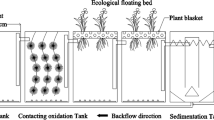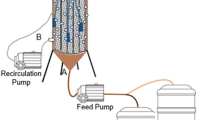Abstract
“Up-flow thermophilic septic tank” (UTST) has been recently developed as an innovative on-site treatment technology to improve the treatment performance of existing sanitation technologies such as septic tanks and cesspools by promoting the growth of thermophilic microorganisms and enhancing the contact between these microorganisms and blackwater. The UTST is an improved version of the conventional solar septic tanks by integrating an up-flow hydraulic mode in the septic tank. The aims of this study were to investigate the effects of hydraulic retention times (HRTs) on the performance of UTST treating blackwater, identify dominant microbial clusters in the UTST and develop a platform for design and operation of the UTST. The experiments were conducted with a laboratory-scale UTST (27 L in size) fed with blackwater collected from public toilets of an academic building. After acclimatization, the laboratory-scale UTST was operated at the HRTs of 8, 16, 24 and 32 h with continuous blackwater feeding for 4 months. The average chemical oxygen demand (COD) removal efficiencies of the laboratory-scale UTST operating at 8, 16, 24 and 32 h at the temperature of 50 °C were 53, 67, 77 and 75%, respectively, while similar trend was observed for the 5-day biochemical oxygen demand (BOD5). Because there were no significant differences (p > 0.05) in COD and BOD5 removal efficiencies between 24- and 32-h HRTs operation, the HRT of 24 h was selected to be optimum. The average CH4 yield by the laboratory-scale UTST operating at 50 °C and HRT of 24 h was found to be 0.037 L/gCODinput. The abundance and dominance of microbial clusters in both liquid and sludge layers in the UTST analyzed by high-sequencing 16S rRNA revealed the abundance and dominance of Methanosaeta and Methanothermobacter responsible for organic degradation and CH4 production. The results of this laboratory-scale experiment on UTST suggested its applicability for blackwater treatment which should lead to better pollution control and public health protection.





Similar content being viewed by others
References
Al-Jamal, W., & Mahmoud, N. (2009). Community onsite treatment of cold strong sewage in a UASB-septic tank. Bioresource Technology,100(3), 1061–1068.
APHA. (2012). Standard methods for the examination of water and wastewater (22nd ed.). Lincoln: American Public Health Association, American Water Works Association, Water Environment Federation.
Burubai, W., Akor, A. J., & Lilly, M. T. (2007). Performance evaluation of a septic System for high water-table areas. American-Eurasian Journal of Scientific Research,2(2), 112–116.
Caporasoa, J. C., Lauberb, C. L., Waltersc, W. A., Berg-Lyonsb, D., Lozuponea, C. A., Turnbaughd, P. J., et al. (2010). Global patterns of 16S rRNA diversity at a depth of millions of sequences per sample. Proceedings of the National Academy of Sciences of the United States of America,108(1), 4516–4522.
Cheng, L., Dai, L., Li, X., Zhang, H., & Lu, Y. (2011). Isolation and characterization of Methanothermobacter crinale sp. nov., a novel hydrogenotrophic methanogen from the Shengli oil field. Applied and Environmental Microbiology,77, 5212–5219.
Etchebehere, C., Pavan, M. E., Zorzopulos, J., Soubes, M., & Muxi, L. (1998). Coprothermobacter platensis sp. nov., a new anaerobic proteolytic thermophilic bacterium isolated from an anaerobic mesophilic sludge. International Journal of Systematic and Evolutionary Microbiology,48(4), 1297–1304.
Farajzadehha, S., Mirbagheri, S. A., Farajzadehha, S., & Shayegan, J. (2012). Lab scale study of HRT and OLR optimization in UASB reactor for pretreating fortified wastewater in various operational temperatures. APCBEE Procedia,1, 90–95.
Karim, K., Klasson, K. T., Hoffmann, R., Drescher, H. R., DePaoli, D. W., & Al-Dahhan, M. H. (2005). Anaerobic digestion of animal waste: Effect of mixing. Bioresource Technology,96(14), 1607–1612.
Kato, M. T., Field, J., Kleerebezem, R., & Lettinga, G. (1994). Treatment of low strength soluble wastewaters in UASB reactors. Journal of Fermentation and Bioengineering,77(6), 679–686.
Koottatep, T., Phuphisith, S., Pussayanavin, T., Panuvatvanich, A., & Polprasert, C. (2014). Modeling of pathogen inactivation in thermal septic tanks. Journal of Water, Sanitation and Hygiene for Development,4(1), 81–88.
Koottatep, T., Pussayanavin, T., Polprasert, C. (2017). Development of a solar heating system for improving performance of on-site sanitation systems. In The IWA S2Small2017 conference on small water and wastewater systems and resources oriented sanitation.
Koottatep, T., Suksiri, P., Pussayanavin, T., & Polprasert, C. (2018). Development of a novel multi-soil layer constructed wetland treating septic tank effluent with emphasis on organic and ammonia removals. Water, Air, and Soil pollution,229, 258.
Lettinga, G., Hulshoff Pol, L. W., Koster, I. W., Wiegant, W. M., De Zeeuw, W. J., Rinzema, A., et al. (1984). High-rate anaerobic waste-water treatment using the UASB reactor under a wide range of temperature conditions. Biotechnology and Genetic Engineering Reviews,2(1), 253–284.
Maune, M. W., & Tanner, R. S. (2012). Description of Anaerobaculum hydrogeniformans sp. nov., an anaerobe that produces hydrogen from glucose, and emended description of the genus Anaerobaculum. International Journal of Systematic and Evolutionary Microbiology,62(4), 832–838.
Menes, R. J., & Muxí, L. (2002). Anaerobaculum mobile sp. nov., a novel anaerobic, moderately thermophilic, peptide-fermenting bacterium that uses crotonate as an electron acceptor, and emended description of the genus Anaerobaculum. International Journal of Systematic and Evolutionary Microbiology,52(1), 157–164.
Metcalf & Eddy. (2014). Wastewater engineering: Treatment and resource recovery (5th ed.). New York: McGraw-Hill.
Polprasert, C., Kemmadamnrong, P., & Tran, F. T. (1992). Anaerobic baffle reactor (ABR) process for treating slaughterhouse wastewater. Environmental Technology,13(9), 857–865.
Polprasert, C., Koottatep, T., & Pussayanavin, T. (2018). Solar septic tanks: A new sanitation paradigm for Thailand 4.0. Science Asia,44S(2018), 39–43. https://doi.org/10.2306/scienceasia1513-1874.2018.44s.039.
Pussayanavin, T., Koottatep, T., Eamrat, R., & Polprasert, C. (2014). Enhanced sludge reduction in septic tanks by increasing temperature. Journal of Environmental Science and Health, Part A,50(1), 81–89.
Smith, K. S., & Ingram-Smith, C. (2007). Methanosaeta, the forgotten methanogen. Journal of Trends in Microbiology,15(4), 150–155.
Tilley, E., Lüthi, C., Morel, A., Zurbrügg, C., & Schertenleib, R. (2008). Compendium of sanitation systems and technologies. Dübendorf: Swiss Federal Institute of Aquatic Science and Technology (EAWAG).
Wasserfallen, A., Nolling, J., Pfister, P., Reeve, J., & Conway de Macario, E. (2000). Phylogenetic analysis of 18 thermophilic Methanobacterium isolates supports the proposals to create a new genus, Methanothermobacter gen. nov., and to reclassify several isolates in three species, Methanothermobacter thermautotrophicus comb. nov., Methanothermobacter wolfeii comb. nov., and Methanothermobacter marburgensis sp. nov. International Journal of Systematic and Evolutionary Microbiology,50, 43–53.
Funding
This research was financially supported by the Bill & Melinda Gates Foundation, Seattle, WA (Grant No. OPP1029022).
Author information
Authors and Affiliations
Corresponding author
Additional information
Publisher's Note
Springer Nature remains neutral with regard to jurisdictional claims in published maps and institutional affiliations.
Rights and permissions
About this article
Cite this article
Koottatep, T., Prapasriket, P., Pussayanavin, T. et al. Performance of up-flow thermophilic septic tank treating blackwater. Environ Dev Sustain 22, 3691–3700 (2020). https://doi.org/10.1007/s10668-019-00362-z
Received:
Accepted:
Published:
Issue Date:
DOI: https://doi.org/10.1007/s10668-019-00362-z




